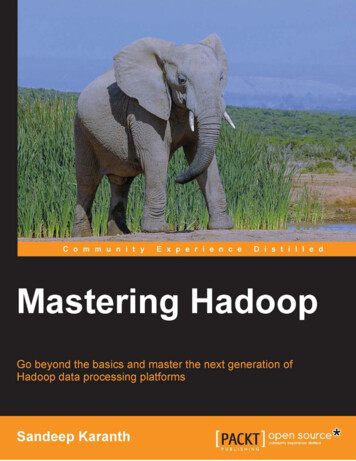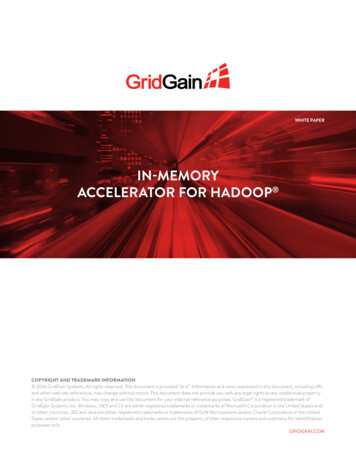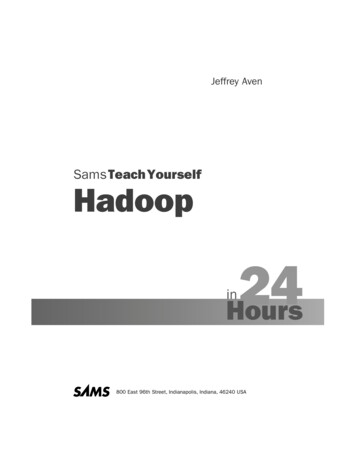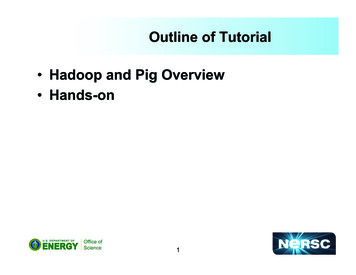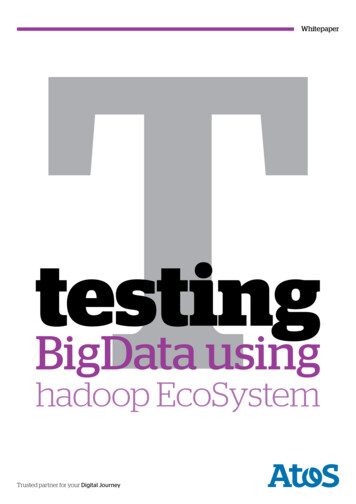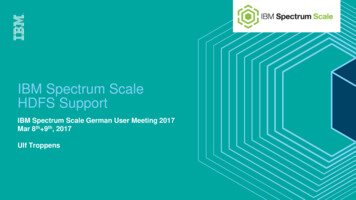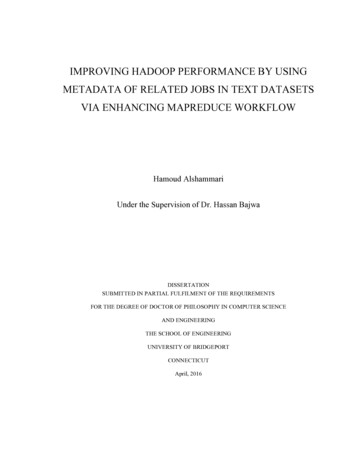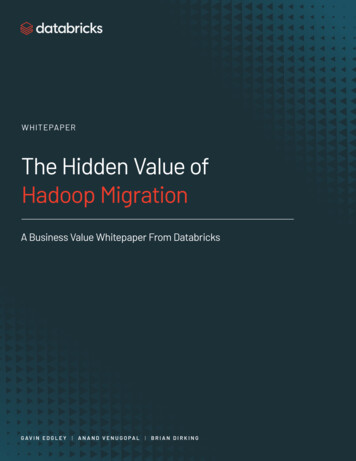
Transcription
W HI T EPA PERThe Hidden Value ofHadoop MigrationA Business Value Whitepaper From DatabricksG AV IN E D G L E Y ANAND VENUGOPAL BRIAN DIRKING
ContentsIntroduction3Infrastructure Costs: Much More Than Licensing3Lowering Infrastructure Costs — Customers Pay for Only What They Use4Raising Productivity5Business-Impacting Use Cases5Customer Examples8Nationwide8Scribd9PicsArt10Don’t Two-Step It11Building Internal Expertise11DATABRICKS WHITEPAPER THE HIDDEN VALUE OF HADOOP MIGRATION2
IntroductionOver the past year, we have seen an acceleration in customers migrating from a Hadoop architectureto a modern cloud architecture. Many organizations have made the move to reduce the operationalcosts of licenses and maintenance, but they’ve also discovered that the power of a modern cloudbased analytics platform quickly outweighs the cost of migration.This whitepaper will help you to uncover some of the hidden value your organization can reap by migrating from Hadoop toa modern cloud-based analytics platform. You can analyze the value of migration by looking at three areas: infrastructure,productivity and business outcomes.BusinessOutcome3Businessimpactinguse cases2ProductivityHigher productivity among data scientists anddata engineers by eliminating manual tasks 1InfrastructureReduced infrastructure spend with lower costsand faster performance Accelerate and expand the realization ofvalue from business-oriented use cases The DataPlatformInfrastructure Costs: Much More Than LicensingMany organizations have found that Hadoop has not delivered on their aspirations to become ananalytics-based company. Some of the inherent limitations of a Hadoop architecture are:1. The development SLAs are too slow to provide the data needed in a timely manner. Often there is a backlog of use caseswaiting to be addressed, and the cost of delivering business-critical data sets is just too expensive.2. The systems don’t provide the governance and management needed to truly build an analytics-driven, self-service dataculture3. The systems do not include an embedded machine learning platform4. The platforms can’t keep up with the rapidly evolving tools and frameworks for ML and AI5. Software upgrades take significant time and are resource intense, robbing the team of time to innovate by just trying tokeep up6. Managing capacity can be difficult and time consuming since adding Hadoop data nodes just for storage is cost prohibitive.Compute and storage need to grow independently.DATABRICKS WHITEPAPER THE HIDDEN VALUE OF HADOOP MIGRATION3
As more companies migrate to modern cloud platforms, Hadoop providers haveraised license costs to make up their losses. This cycle has led more companiesto migrate from Hadoop on-premises to lower their total cost of ownership. Theseorganizations focus on the comparative cost of licensing, which alone makes acompelling case to migrate, but doesn’t show the true value that makes a platformchange an urgent project for the organization. To get a true sense of what Hadoop8%“Only 8% of the big data projects areregarded as VERY successful.”—CAPGEMINIis costing your organization, you have to step back. From a benchmark of 10Databricks customers, we found that licensing is less than 15% of total cost. Theother costs are made up of the following: Data center management is nearly half the total cost. This includes propertycosts, cooling and management. Power often costs 800 per server per yearbased on consumption and cooling, leading to an 80K annual bill for a 100node Hadoop cluster. Excess hardware. Overcapacity is common for on-premises implementationsbecause it allows you to scale up to meet your largest needs, but muchof that capacity sits idle most of the time. The ability to separate storageand compute does not exist, so costs grow as data sets grow, and mostorganizations have big data sets.85%“Close to 85% of big data projects fail.”—GARTNER95%More than 95% of committedDatabricks customers meet theirobjective and timelines.Customers see a number of ways theirtotal cost of ownership is lower withDatabricks in the cloud than runningHadoop on-premises. Administration of the Hadoop clusters. Many organizations assume 4–8 fulltime employees for every 100 nodes.Lowering Infrastructure Costs —Customers Pay for Only What They UseDatabricks is priced based on consumption — you only pay for what you use. But Databricks providesa more economical solution in a number of ways: Autoscaling ensures customers only pay for the infrastructure they use In the cloud, capacity can scale to meet changing demand in minutes, not weeks or months Storage and compute are kept separate, so adding more storage does not require adding expensive compute resourcesat the same time Databricks enables users to select GPUs and other high-performance processing options to increase performance evenfurther, but then to also select lower-performance processing for lower-cost daily jobs Expensive data center management and hardware costs disappear entirelyDATABRICKS WHITEPAPER THE HIDDEN VALUE OF HADOOP MIGRATION4
The faster processing of Databricks means beating SLAs and keeping costs down: Founded by the original creators of Apache Spark and Delta Lake, Databricks delivers the most highly tuned processingengine in the world, up to 50x faster than open source Spark Databricks has also introduced open source Delta. Running on Databricks as the Delta Lake service, it provides many moreperformance improvements, optimizing data through features such as Z-ordering, data skipping and file compaction. Take advantage of data immediately as it is introduced with streaming data, and combine it with historical data to provideinstant insights that are critical in security and financial services use casesRaising ProductivityData scientists and data engineers are expensive resources. One of the best ways organizations cansave money is to maximize the productivity of data teams.The big surprise for many customers is how the Databricks platform facilitates collaboration. Data teams are more efficientbecause Databricks Notebooks enable collaboration. Typically teams would correspond via email or Jira tickets, now theyjust comment in the Notebooks. Many teams talk about how this has had a 10x impact on accelerating innovation.Business-Impacting Use CasesWith Databricks, customers are able to move beyond the limitations of Hadoop and address morecritical use cases. These organizations find that the power of a modern cloud-based analytics platformquickly outstrips the cost of the migration due to the ability to address more advanced use cases. Delivering data to business users faster for better and more timely business decisions Delivering consistent data from a shared data lake properly governed to ensure the entire organization is working offthe same data Greater scalability to take on the largest ML and AI use cases — such as curing diseases and intrusion detection — toenable analytics with greater impact through finding new markets and increasing revenue, reducing costs, lowering risk Larger historical data sets are available to business decision makers — providing the ability to visualize your entiredata lake, while keeping costs low through a pay-for-what-you-use architectureDATABRICKS WHITEPAPER THE HIDDEN VALUE OF HADOOP MIGRATION5
I N F RAST RU CT U REP RO DUCT IVIT YB USINESS IMPACTDatabricks drives value for customers in three areas: infrastructure, productivity and business impact.1. Databricks lowers infrastructure costs with optimized Apache Spark and Delta Lake performance gains, and automation thatmanages clusters more efficiently and cost effectively2. Databricks makes data teams more productive through a unified, collaborative workspace that reduces the complexity ofmultiple tools and handoffs that plague many data science and data engineering teams3. Databricks scales to handle the most impactful use cases, which often require huge amounts of data, and throughcollaborative tools that enable the teams to work together more effectively and accelerate innovationOrganizations find that migrating to Databricks pays for itself quickly, and puts them on course to have a much bigger impactas an analytics-driven organization. We have found that in many cases we can automate portions of the migration process,reducing migration costs and duration significantly.Part of the way we help customers identify the impact of migration is a thorough assessment of customer costs as well as aforecast of their future costs with their current platform versus a new platform.An example of some of the inputs we use in the model are shown in Figure 1. The numbers in the Value column represent anaverage we have seen over a group of customers (hence, numbers like 5.2 employees).UNITSVA L U EHow many nodes in your Hadoop cluster?# nodes156How many people supporting your Hadoop cluster?# FTE5.2When is your Hadoop renewal?Months from today3 How do you expect your capacity needs to grow?% growth per year20%Total professional services costs for migration How long do you expect your migration to take?Months 450,0003 Figure 1: Model inputsDATABRICKS WHITEPAPER THE HIDDEN VALUE OF HADOOP MIGRATION6
A typical customer result looks like Figure 2. In this scenario, we show the net savings each year by migrating to Databricks.These numbers are based on the averages from a set of real-life customers.UNITSYEAR 1YEAR 2YEAR 3T O TA LDO-NOTHING SCENARIO 5,343,515 7, 4 1 8 , 4 1 8 9 , 8 3 8 ,1 0 2 22,600,035Total – Hadoop 5,343,515 7,418,418 9,838,102 22,600,035Hardware 624,000 1,372,800 2,271,360 4,268,160Hadoop administration 1,178,315 1,413,978 1,696,774 4,289,067Data center costs 2,574,000 3,556,800 4,736,160 10,866,960Hadoop license 967,200 1,074,840 1,133,808 3,175,848Figure 2: Forecasted costs of current platformWe can show this impact for many customers, as in Figure 3. This figure shows dollars of cumulative present value over threeyears. Most organizations see payback within two quarters. 13.8 M in potential value with Databricks 20,000,000 10,000,000 13.8 MPotential Databricks value 12.8 MNet impact- 4.9 MInvestment – Databricks,migration and cloud- 18.7 MHadoop – costsIncludes running Hadoop andDatabricks in parallel 0- 10,000,000- 20,000,000Q1Q2Q3Q4Q5Q6Q7Q8Q9Q10Q11Q12Figure 3: Hadoop costs vs. Databricks value and investmentDATABRICKS WHITEPAPER THE HIDDEN VALUE OF HADOOP MIGRATION7
A CU STOMER EXA MPLENationwide chose Databricks for actuarial modeling. They are able to optimize insurance pricingby leveraging data and machine learning. Nationwide chose Databricks because it provides:1. A unified platform to simplify infrastructure management, enabling fast data pipelines at scale and streamliningthe ML lifecycle2. A deep learning platform using hierarchical neural networks to provide more accurate pricing predictions,resulting in more revenueNationwide has seen positive impact in a number of ways:1. Self-service: Actuaries are now able to make decisions based on large volumes of data previously locked away in silos2. 9x faster data pipelines, improving runtime from 34 hours to less than 4 hours3. 5x improvement in featurization speeds for downstream ML4. 50% reduction in time to train and deploy ML models5. 25% improvement in productivity of high-value data engineers and data scientistsDATABRICKS WHITEPAPER THE HIDDEN VALUE OF HADOOP MIGRATION8
A CU STOMER EXA MPLEScribd is an American eBook and audiobook subscription service that includes 1 million titlesand hosts 60 million documents on its open-publishing platform. Scribd had a Hadoop-based“conventional data platform” with a Hadoop Distributed File System (HDFS) and a smattering of Hive.Over time the business changed, and Scribd needed more machine learning,more real-time data processing, and more support for teams collaborating todeliver new data products.Their data platform now consists of a combination of Airflow, Databricks,Delta Lake and AWS Glue Catalog, a powerful data platform that has improveddevelopment velocity and collaboration significantly.Scribd has backfilled their entire data warehouse into Delta Lake and hasdeployed new projects onto Databricks while continuing the migration. Scribdautomated migration for about 80% of their Hive workloads over to Databrickswith their own tooling.INGESTIONPROCESSINGOUTPUTExport DBMobile Analyticsrec tracking“Scribe”Redis CacheSidekiqAdmin table““Databricks claimed an optimizationof 30%–50% for most traditionalSpark workloads. Out of curiosity, Irefactored my cost model to accountfor the price of Databricks and thepotential Spark job optimizations.After tweaking the numbers, Idiscovered that at a 17% optimizationrate, Databricks would reduceour Amazon Web Services (AWS)infrastructure cost so much thatit would pay for the cost of theDatabricks platform itself. After ourinitial evaluation, I was already soldon the features and developer velocityimprovements Databricks wouldoffer. When I ran the numbers in mymodel, I learned that I couldn’t affordnot to adopt Databricks!”— R. TYLER CROY,D I R E C T O R O F P L AT F O R ME N G I N E E R I N G AT S C R I B DMySQLSqoopsTableau DashboardES Index LoaderWeb EventsS3 bucketsad hocS3-backed Delta LakeDatabricksDATABRICKS WHITEPAPER THE HIDDEN VALUE OF HADOOP MIGRATIONFigure 4: The Scribd data platform on AWSGrafana9
A CU STOMER EXA MPLEPicsArt makes an app for photo editing. With 500 million-plus installs and 140 million monthlyusers, PicsArt spans the globe. Their Hadoop architecture led to slow business insights and missedconversion opportunities. Their strategic objectives include:1. Build a scalable data infrastructure to support the company ’s rapid growth2. Provide faster insights to add critical new features to increase engagement and improve conversion:a. Exploratory analysis and A/B testsb. Fraud detection (“copy cats”)c. Recommendations (stickers, feed, etc.)In their Hadoop-based environment, storage and compute were tightly coupled:1. Adding new infrastructure was slow and expensive as physical servers are spun up2. Stability was at risk as business demands fluctuatedSignificant efforts were spent on performance management and maintenance. The infrastructure limited A/B tests toapproximately 15 in parallel. There was a high potential to increase conversions with many more experiments. Just onetest led to changes that increased subscription rates by 15% per day. PMs wanted to draw insights on user behavior butwere limited to 1–3 day analytics delays. The analytics team needed to build capabilities in modern technologies, such asstructured streaming and an optimized data lake. The organization wanted to avoid rework when migrating to a modernarchitecture, and leverage expertise to get it right the first time.Databricks brought value to PicsArt in these ways:1. A scalable, reliable, managed architecture built natively in the cloud (Databricks runtime, Delta Lake, etc.)2. Collaborative workspaces that enable their data scientists, engineers and analysts to collaborate, accelerating their rateof innovation3. Databricks is providing production support and expertise in professional services and trainingDATABRICKS WHITEPAPER THE HIDDEN VALUE OF HADOOP MIGRATION10
Don’t Two-Step ItMany organizations try to take their Hadoop experience and re-create it in the cloud. They bring the same problems withthem. The faster way to maximize business value is going directly to Databricks.Databricks value frameworkDirect toDatabricksOpen sourcethen DatabricksABIMPAC TCloud DatabricksAPPROACHADirect toDatabricks Partner with Databricksexperts to accelerate andde-risk project delivery Extract the greatest valuefrom the models thatare producedBOpen sourcethen Databricks Slower time to value Greater risk of slowerproject executionCloud opensource SparkHadoopIMPAC TTIMEFigure 5: Value impact of direct migrationBuilding Internal ExpertiseYour teams can take their knowledge of data architectures and apply it to Databricks. Over 100,000 people register forData AI Summits annually to find out how companies are moving forward with a modern cloud-based data and analyticsarchitecture. The Apache Spark community has over 500,000 members, much larger compared to other tools — making itmuch easier to build teams. Databricks also provides free training, including this series.DATABRICKS WHITEPAPER THE HIDDEN VALUE OF HADOOP MIGRATION11
EVA LUATE D ATA BR ICKS FO R YO UR S E L FS TA R T YO U R F R E E T R I A LContact us for a personalized demo databricks.com/contactTo learn more about migration, visit databricks.com/migration Databricks 2020. All rights reserved. Apache, Apache Spark, Spark and the Spark logo are trademarks of the Apache Software Foundation. Privacy Policy Terms of Use
Figure 3: Hadoop costs vs. Databricks value and investment 20,000,000 10,000,000 0- 10,000,000- 20,000,000 Q1 Q2 Q3 Q4 Q5 Q6 Q7 Q8 Q9 Q10 Q11 Q12- 18.7 M Hadoop - costs- 4.9 M Investment - Databricks, migration and cloud 13.8 M Potential Databricks value 12.8 M Net impact Includes running Hadoop and Databricks in parallel


